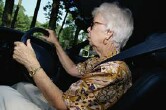
MONDAY, Feb. 21 (HealthDay News) — A new review of existing research contends that three brief tests could help doctors figure out whether recovering stroke patients are well enough to drive.
“A quick and objective screening in the doctor’s office can help them to make more accurate decisions,” said review author Hannes Devos, a research assistant at Katholieke Universiteit Leuven in Belgium.
However, several U.S. stroke experts said they weren’t ready to accept the new study’s findings.
The American Heart Association estimates that 6.4 million stroke survivors are alive in the United States today. While some patients are able to recover with few permanent disabilities, strokes can cause some people to permanently lose memory and the ability to properly move their bodies.
In some cases, patients with serious motor-skill problems can still drive a car as long as they’re able to get proper equipment, such as an automatic transmission, a left-sided accelerator pedal for patients who have trouble moving their right side, and steering knobs that allow one-handed driving, Devos said.
Stroke patients may need to get approval from a physician before they can legally begin driving again, but evaluation processes in the office can sometimes be a challenge. “Some physicians do not feel confident to screen for fitness to drive because they lack standardized tools that can be administered in the doctor’s office,” Devos said.
With that in mind, Devos and colleagues reviewed 30 surveys and included 27 in an overall statistical analysis. In total, the studies evaluated various screening tests before patients took on-road driving tests; 54 percent of 1,728 patients (average age 61) passed the driving tests.
The researchers found that three screening tests had accuracy levels of 80 percent to 85 percent for determining how patients would fare on an on-road driving test. One of the tests asks patients to match road signs to driving situations. Another requires patients to match cue cards in a mockup of a driving roundabout or rotary. The third test asks patients to connect 25 circles while alternating between numbers and letters in consecutive order, Devos said.
The tests only take about 15 minutes and doctors can easily administer them during a routine visit, Devos said.
So should the tests be administered?
Dr. Larry B. Goldstein, professor of medicine and director of the Duke Stroke Center at Duke University Medical Center, is skeptical, pointing out that the tests didn’t correctly identify 15 percent to 20 percent of unsafe drivers, and they may also fail to identify safe drivers.
“I am not sure whether it is practical to include a formal driving assessment as part of the routine post-stroke follow-up visit or whether the cost would be reimbursed,” he said, adding that patients can choose to be tested in a driving simulator before hitting the road as part of a test.
Dr. Jeffrey L. Saver, a professor of neurology and director of the University of California, Los Angeles Stroke Center, said the office tests might be helpful if patients and families aren’t sure whether to spend money on on-road driving tests.
“However, on-road assessment will remain the gold standard and likely will continue as the approach generally pursued by physicians for patients with deficits that could potentially impair driving,” he said.
The study appears in the Feb. 22 issue of the journal Neurology.
More information
For more about stroke, visit the U.S. National Library of Medicine.

